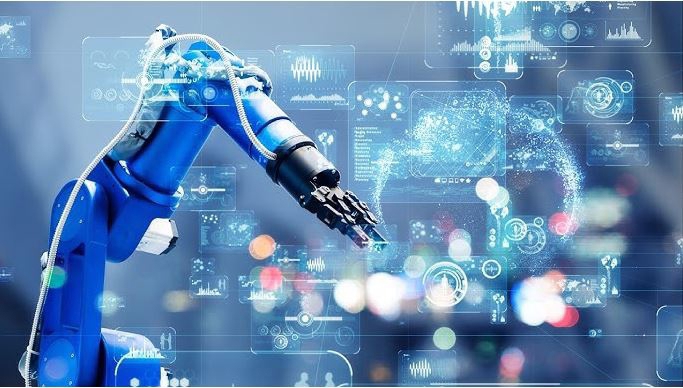A new perspective from Resolution 57
Mr. Nguyen Trong Khang, Founder and Chairman of the MK Group, tells Vietnam Economic Times / VnEconomy’s Manh Chung and Ngo Huyen about the introduction of Politburo Resolution No. 57 on science and technology, innovation, and digital transformation.

On behalf of the Politburo, Party General Secretary To Lam signed Politburo Resolution No. 57-NQ/TW on December 22, 2024, regarding breakthroughs in science and technology development, innovation, and digital transformation. As a tech entrepreneur, what do you think of the aspirations shown in the Resolution?
It must be said that the desire to master technology is not exclusive to Vietnam; it is a universal aspiration of all nations.
We often talk about technology. But what technologies are we referring to? Are they internationally competitive? Let’s examine each industry: precision engineering, automation, biology, healthcare, information technology, and others. Which are spearhead industries? Which can compete globally? Which have truly mastered the technology?
So, in each industry, we must identify the spearhead: What is it? Who will take the lead? What does it mean to master technology? Can it generate profit? Can it compete internationally? At the MK Group, these are the critical questions we pose in tackling our own challenges in technology mastery.
Politburo Resolution No. 57 contains many new features, such as allowing for the purchase or replication of advanced global technologies. What is your view on the approach to mastering science, technology, innovation, and digital transformation outlined in the Resolution?
In my view, this is a new perspective; one that embraces risk, investment, and openness to scientific research and development. However, we must proceed based on specific “orders”. For example, what problems is the country currently facing, and how can innovation and technology help address them? Who is capable of doing it? What is the solution? How will the government invest?
This must be a public-private partnership. Take the example of national ID cards. The State has demand, so it invites the best-performing private companies in ID card technology to participate. The State pays for the product, businesses invest in the technology, and all of it is aligned with their business development needs.
Another example: Vietnam is planning to develop high-speed railway, which is a critical infrastructure project for national development. The question is: can Vietnamese companies build it? What are the core technologies involved? Which Vietnamese enterprises can participate? If they are not fully capable, then we must cooperate with international companies to handle part of it, and those foreign partners must transfer their technology. In this way, the government shapes the policy, sets the playing field, and allows Vietnamese players to take ownership and absorb foreign technologies, with the long-term goal of mastering them.
That’s how the game should be played. The government creates the ecosystem and assembles high-level expert councils. Outstanding individuals will resolve these challenges.
For industry insiders, there is great excitement over Politburo Resolution No. 57, but in the end, it all comes down to action. We need industrialists, strategists, and technologists, and, most importantly, internal strength.
We also need to bring back talented overseas Vietnamese to “join the game” domestically, to understand Vietnam’s real issues, which evolve by the hour and by the day, and to be willing to tackle them.
In today’s context, where most global conflicts, interests, and power competition are fundamentally centered around technological issues such as semiconductors, AI, and cybersecurity technologies, what is the significance of Vietnam aiming to master technology, especially core and strategic technologies?
The current geopolitical landscape has changed significantly, and so has the global supply chain. Vietnam holds certain geopolitical advantages, maintains relationships with all nations, and has a very open economy.
Two-way trade turnover between Vietnam and the US now exceeds $100 billion, while Vietnam’s imports from China have also increased considerably. Vietnamese industry is developing, but it is still dominated by foreign-invested enterprises, not by Vietnamese players. So, where does Vietnam really stand?
A major export-driven economy won’t lack foreign currency, but it is also highly susceptible to external shocks. Within a value chain consisting of multiple components, each sector needs to define its role. Globally, those who profit the most aren’t necessarily the manufacturers, but those who hold the core technologies. Even raw materials can be considered core technologies, as certain types of materials are extremely specialized and valuable.
Scientists must be able to see this clearly. If it is applied science, it must lead to results - it must produce something concrete, or at least achieve a breakthrough. Those who generate significant value often achieve a major breakthrough, whether it’s through a massive user base or large viewership. TikTok is a prime example.
Whatever we aim to do, it must involve breakthroughs. Breakthroughs also serve to create differentiation.
During a working session with the Central Commission for Policy, Strategy in early March, Party General Secretary Lam discussed the need to create breakthroughs for enterprise development, saying that “people and businesses are allowed to do anything that is not explicitly prohibited by law.” I completely agree with this view. In many countries, the State only steps in to do what the private sector cannot, while the State should not interfere with anything that private enterprises can handle.
Politburo Resolution No. 57 sets out highly ambitious and aspirational goals and plans, such as gradually mastering certain strategic and digital technologies like AI, semiconductors, nanotechnology, 5G and 6G mobile communications, satellite information, and more. In your opinion, how capable is Vietnam internally of realizing these goals and aspirations?
There needs to be clearly defined, task-oriented implementation, much like the digital transformation initiative. Previously, the government’s Steering Committee on Science and Technology Development, Innovation, Digital Transformation, and Project 06 met regularly and worked constantly, which led to rapid outcomes. For instance, few believed that the rollout of the new national ID card system could be completed in such a short time.
At the MK Group, we were the Ministry of Public Security’s partner in producing national ID cards. During the campaign, there were days when we printed up to 430,000 cards. To achieve that, the entire process had to be automated and tightly controlled, ensuring that the printed data, photo, fingerprint, and chip information matched exactly with the database and on the physical card. That was only possible because MK had prepared for it ten years in advance.
From what I observe, many Indians, South Koreans, Japanese, and Chinese have worked in senior management roles at global corporations and later went on to launch startups that have grown into powerful multinational companies.
Many Vietnamese have also held management positions at global firms, and we are passionate about technology. However, we often lack a strong desire to dream big or break through limits. We tend to be content with what we have, and that’s why very few Vietnamese have stepped out to start their own ventures and grow them into globally-recognized startups. This is something we must study and reflect on, especially if our future vision is to build a Vietnam with global stature and influence.
In Politburo Resolution No. 57, Vietnam sets the goal of gradually mastering core and strategic technologies. What do you believe qualifies as core or strategic technology?
There are many types of core technologies, for example technologies related to space, semiconductors, biotechnology, and medical technologies that improve health, extend life expectancy, and treat disease. All of these are considered core technologies, and their “core” nature lies in their long-term competitiveness.
Of course, what is considered a core technology today, like a rocket, for instance, might no longer be seen as such after certain advancements. But once upgraded, that same rocket may no longer be core. So timing plays a crucial role.
Anything that creates significant value and holds strategic importance for a nation, be it in the realm of military, economics, healthcare, new materials, or new energy, can be considered core technology. Core and strategic technologies must: (i) address the urgent and long-term strategic needs of the country; and (ii) create sustainable, long-lasting value and fundamentally transform the position of a nation or its people.
Looking globally, which core and strategic technologies are nations currently focusing their investments on?
First and foremost, tech-leading nations have dedicated investment funds, which are the engines driving their development. They also have outstanding individuals. For instance, once the US identified AI as a priority, it boldly invested up to $500 billion in the industry.
Therefore, for a country to develop, in my view, it must clearly determine what is truly important, what has the potential to change the game. In reality, few nations can truly identify that. Many countries surrounding Vietnam are still stuck in the middle-income trap precisely because they haven’t found their unique edge or the factor that could transform their trajectory.
What is your assessment of Vietnam raising the issue of “purchasing technological know-how, learning and copying advanced technologies from foreign countries” in Politburo Resolution No. 57?
In the tech industry, the word “copy” is very sensitive. If a country wants to replicate or learn from the technologies of others, it must have their consent. To gain that consent, you need strong relationships and ensure that they also benefit. Otherwise, development becomes extremely difficult.
Vietnam may not yet be a country with many groundbreaking inventions, but we do have a particular strength: the ability to improve upon and rebuild older technologies. Therefore, the matter of technology transfer or deep international cooperation is a critical driver for Vietnam’s technological advancement.
Are there any countries that Vietnam could learn from in terms of strategies or methods for “purchasing technological know-how, learning and copying advanced technologies from foreign countries”?
I don’t think there’s a one-size-fits-all model Vietnam can replicate. Each country has its own unique history and development path, marked by successes and mistakes.
We have launched many strategies over the years, yet results have often fallen short of expectations. For example, while the Law on Technology Transfer encourages businesses to adopt foreign technologies, it also imposes a 10 per cent contractor tax, effectively making new tech acquisitions 10 per cent more expensive.
Strategic technologies should originate from the State, but actual technology transfer should be handled by private enterprises, under State directives. For instance, if we need missile technology and a foreign country offers it at hundreds of millions of USD, instead of accepting that price, the State could set a lower price. Any business able to meet that target would secure the deal.
Technology transfer should be carried out by enterprises, who understand the true value of technology better than anyone. But the State must provide financial backing. Some investments may fail, but others could bring breakthroughs. In science, experimentation is everything. And experiments may fail. But if we never begin, there can be no end.
In my view, there are many ways the government could accompany businesses in this effort. For example, to encourage AI development, the State could build national AI data centers or publicly-funded environments that allow companies, tech experts, and students to access vast computational resources to experiment and develop new models and explore applications in diverse fields relevant to Vietnam.
To attract individuals with exceptional skills, knowledge, and experience who can contribute to Vietnam’s socio-economic development, the country should consider introducing a “Talent Visa” policy. This would allow long-term residence and work rights, along with access to Vietnam’s social welfare system. Many countries are currently implementing such policies.
What policies and mechanisms should Vietnam adopt in approaching, purchasing, and copying advanced foreign technologies and technological know-how?
Vietnam’s technological capacity still lags behind that of many other countries. Other Southeast Asian nations are rapidly reforming policies to foster innovation. This is a race to escape the middle-income trap.
I believe Vietnam should establish dedicated funds to acquire strategic technologies. For example, such funds could support Vietnamese companies in acquiring foreign firms that own core technologies. The State should develop a strategy to help domestic companies buy foreign tech firms and bring their talent back to Vietnam.
If cooperation is one-sided, with us always at the lower end, we won’t grow. We must engage in equal partnerships, and avoid relying solely on one party. Take the railway project, for example. Invite the best global companies to participate, but let Vietnam lead and assign tasks to each party, while requiring technology transfer. If we merely allow them to invest and build, with Vietnamese workers only providing labor, no technology will be retained in Vietnam.







